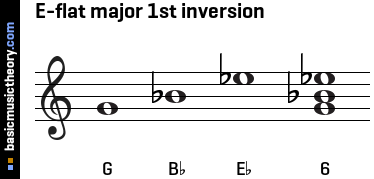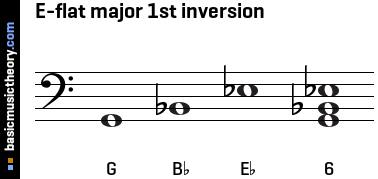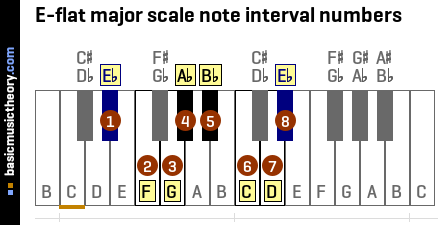E-flat major triad chord
The Solution below shows the E-flat major triad chord in root position, 1st inversion and 2nd inversion on the piano, treble clef and bass clef.
The Lesson steps then explain how to construct this triad chord using the 3rd and 5th note intervals, then finally how to construct the inverted chord variations.
For a quick summary of this topic, have a look at Triad chord.
| Key | C | C# | Db | D | D# | [Eb] | E | E# | Fb | F | F# | Gb | G | G# | Ab | A | A# | Bb | B | B# | Cb |
|---|
Solution - 3 parts
1. E-flat major chord
The E-flat major chord contains 3 notes: Eb, G, Bb.
The chord spelling / formula relative to the Eb major scale is: 1 3 5.
| Note no. | Note interval | Spelling / formula | Note name | #Semitones from root |
|---|---|---|---|---|
| 1 | root | 1 | The 1st note of the E-flat major chord is Eb | 0 |
| 2 | Eb-maj-3rd | 3 | The 2nd note of the E-flat major chord is G | 4 |
| 3 | Eb-perf-5th | 5 | The 3rd note of the E-flat major chord is Bb | 7 |

Middle C (midi note 60) is shown with an orange line under the 2nd note on the piano diagram.
These note names are shown below on the treble clef followed by the bass clef.


The figured bass symbols for this chord in root position are 5/3.
The staff diagrams and audio files contain each note individually, ascending from the root, followed by the chord containing all 3 notes.
 Bass Clef
Bass Clef
 Treble Clef
Treble Clef
2. E-flat major 1st inversion
The E-flat major 1st inversion contains 3 notes: G, Bb, Eb.

These note names are shown below on the treble clef followed by the bass clef.


The figured bass symbols for this chord inversion are 6/3, so the chord is said to be in six-three position.
 Bass Clef
Bass Clef
 Treble Clef
Treble Clef
3. E-flat major 2nd inversion
The E-flat major 2nd inversion contains 3 notes: Bb, Eb, G.

These note names are shown below on the treble clef followed by the bass clef.


The figured bass symbols for this chord inversion are 6/4, so the chord is said to be in six-four position.
 Bass Clef
Bass Clef
 Treble Clef
Treble Clef
Lesson steps
1. Piano key note names
The white keys are named using the alphabetic letters A, B, C, D, E, F, and G, which is a pattern that repeats up the piano keyboard.
Every white or black key could have a flat(b) or sharp(#) accidental name, depending on how that note is used. In a later step, if sharp or flat notes are used, the exact accidental names will be chosen.

The audio files below play every note shown on the piano above, so middle C (marked with an orange line at the bottom) is the 2nd note heard.
 Bass Clef
Bass Clef
 Treble Clef
Treble Clef
2. E-flat tonic note and one octave of notes
The numbered notes are those that might be used when building this chord.
Note 1 is the root note - the starting note of the chord - Eb, and note 13 is the same note name but one octave higher.

| No. | 1 | 2 | 3 | 4 | 5 | 6 | 7 | 8 | 9 | 10 | 11 | 12 | 13 |
|---|---|---|---|---|---|---|---|---|---|---|---|---|---|
| Note | Eb | E | F | F# / Gb | G | G# / Ab | A | A# / Bb | B | C | C# / Db | D | Eb |
 Bass Clef
Bass Clef
 Treble Clef
Treble Clef
3. E-flat major scale note interval positions
The major scale uses the W-W-H-W-W-W-H note counting rule to identify the scale note positions.
To count up a Whole tone, count up by two physical piano keys, either white or black.
To count up a Half-tone (semitone), count up from the last note up by one physical piano key, either white or black.
The tonic note (shown as *) is the starting point and is always the 1st note in the major scale.

| No. | 1 | 2 | 3 | 4 | 5 | 6 | 7 | 8 |
|---|---|---|---|---|---|---|---|---|
| Note | Eb | F | G | G# / Ab | A# / Bb | C | D | Eb |
 Bass Clef
Bass Clef
 Treble Clef
Treble Clef
4. E-flat major scale note interval numbers
To identify the note interval numbers for this major scale, just assign each note position from the previous step, with numbers ascending from 1 to 8.
| No. | 1 | 2 | 3 | 4 | 5 | 6 | 7 | 8 |
|---|---|---|---|---|---|---|---|---|
| Note | Eb | F | G | Ab | Bb | C | D | Eb |
To understand why the note names of this major scale have these specific sharp and flat names, have a look at the Eb major scale page.

5. Triad chord qualities
Triad chord definition
The music theory term triad chord means that 3 or more notes played together, or overlapping.
Triad chord qualities
Triad chords exist in five different chord qualities, which are major, minor, augmented, and diminished.
Each chord quality name is the name of the entire chord as a whole, not its individual notes (which will be covered later).
Triad chord qualities using the 1st, 3rd and 5th scale notes
All of these triad qualities are based on the 1st, 3rd and 5th notes of the major scale piano diagram above.
Depending on the chord quality, the 3rd and 5th scale note names of the major scale above might need to be adjusted up or down by one half-note / semitone / piano key.
It is these variations of the 3rd and 5th notes that give each one a distinctive sound for any given key (eg. C-flat, E etc).
Suspended triad chords - using the 2nd or 4th scale notes
A suspended chord is known in music theory as an altered chord because it takes one of the above chord qualities and modifies it in some way.
Unlike all of the above qualities, Suspended triad chords do not use the 3rd note of the major scale (at all) to build the chord.
The 3rd note is suspended, ie. removed completely, and replaced by either the 2nd note of the major scale - a suspended 2nd, or more commonly by the 4th note of the major scale - a suspended 4th.
Musically, this is interesting, since it is usually the 3rd note of the scale that defines the overall character of the chord as being major (typically described as 'happy') or minor ('sad').
Without this 3rd note, suspended chords tend to have an open and ambiguous sound.
The steps below will detail the major triad chord quality in the key of Eb.
6. Triad chord note intervals
Each individual note in a triad chord can be represented in music theory using a note interval, which is used to express the relationship between the first note of the chord (the root note), and the note in question.
The root note is always the 1st note (note interval 1 in the above diagram) of the major scale diagram above. ie. the tonic of the major scale.
Then there is one note interval to describe the 2nd note, and another to describe the 3rd note of the chord.
In the same way that the entire chord itself has a chord quality, the intervals representing the individual notes within that chord each have their own quality.
These note interval qualities are diminished, minor, major, perfect and augmented.
Below is a table showing the note interval qualities for all triad chords, together with the interval short names / abbrevations in brackets.
| Chord quality | 2nd note quality | 3rd note quality |
|---|---|---|
| major | major (M3) | perfect (P5) |
| minor | minor (m3) | perfect (P5) |
| augmented | major (M3) | augmented (A5) |
| diminished | minor (m3) | diminished (d5) |
| suspended (2nd/4th) | major (M2) or perfect (P4) | perfect (P5) |
The numbers in brackets are the note interval numbers (ie the scale note number) shown in the previous step.
E-flat triad chord note intervals
Looking at the table above, the note intervals for the chord quality we are interested in (major triad), in the key of Eb are Eb-maj-3rd and Eb-perf-5th.
The links above explain in detail the meaning of these note qualities, the short abbrevations in brackets, and how to calculate the interval note names based on the scale note names from the previous step.
7. E-flat major triad chord in root position
Note name adjustments
Each note interval quality (diminished, minor, major, perfect, augmented) expresses a possible adjustment ie. a possible increase or decrease in the note pitch from the major scale notes in step 4.
If an adjustment in the pitch occurs, the note name given in the major scale in step 4 is modified, so that sharp or flat accidentals will be added or removed.
But crucially, for all interval qualities, the starting point from which accidentals need to be added or removed are the major scale note names in step 4.
For this chord, this is explained in detail in Eb-maj-3rd and Eb-perf-5th, but the relevant adjustments for this major chord quality are shown below:
Eb-3rd: Since the 3rd note quality of the major scale is major, and the note interval quality needed is major also, no adjustment needs to be made. The 3rd note name - G, is used, and the chord note spelling is 3.
Eb-5th: Since the 5th note quality of the major scale is perfect, and the note interval quality needed is perfect also, no adjustment needs to be made. The 5th note name - Bb is used, and the chord note spelling is 5.
E-flat major triad chord note names
The final chord note names and note interval links are shown in the table below.
| Note | Eb | G | Bb |
|---|---|---|---|
| Interval No. | 1 | 3 | 5 |
| Interval def. | root | Eb-maj-3rd | Eb-perf-5th |
| Spelling | 1 | 3 | 5 |
| #Semitones | 0 | 4 | 7 |
The piano diagram below shows the interval short names, the note positions and the final note names of this triad chord.

In music theory, this triad chord as it stands is said to be in root position because the root of the chord - note Eb, is the note with the lowest pitch of all the triad notes.
The note order of this triad can also be changed, so that the root is no longer the lowest note, in which case the triad is no longer in root position, and will be called an inverted triad chord instead.
For triad chords, there are 2 possible inverted variations as described in the steps below.
Figured bass notation
The figured bass notation for a triad in root position is 5/3, with the 5 placed above the 3 on a staff diagram.
These numbers represent the interval between the lowest note of the chord and the note in question.
So another name for this chord would be E-flat major triad in five-three position.
For example, the 5 represents note Bb, from the Eb-5th interval, since the triad root, Eb, is the lowest note of the chord (as it is not inverted).
In the same way, the figured bass 3 symbol represents note Bb, from the Eb-3rd interval.
Since figured bass notation works within the context of a key, we don't need to indicate in the figured bass symbols whether eg. the 3rd is a major, minor etc. The key is assumed from the key signature.
Often, for a triad in root position, these symbols usually not shown at all, since it is assumed that the triad is shown in root position (ie not inverted), unless otherwise indicated as shown below.
 Bass Clef
Bass Clef
 Treble Clef
Treble Clef
8. E-flat major 1st inversion
Structure
To invert a chord, simply take the first note of the chord to be inverted (the lowest in pitch) and move it up an octave to the end of the chord.
So for a 1st inversion, take the root of the triad chord in root position from the step above - note Eb, and move it up one octave (12 notes) so it is the last (highest) note in the chord.
The second note of the original triad (in root position) - note G is now the note with the lowest pitch.

Figured bass notation
The figured bass notation for this triad in 1st inversion is 6/3, with the 6 placed above the 3 on a staff diagram.
Based on this numbering scheme, another name for this inversion would be E-flat major triad in six-three position.
These numbers represent the interval between the lowest note of the chord (not necessarily the original triad root!), and the note in question.
For example, the 6 represents note Eb, from the G-6th interval, since the lowest (bass) note of the chord - now inverted, is G.
In the same way, the figured bass 3 symbol represents note Bb, from the G-3rd interval.
Often the 3 symbol is not shown at all, and only the number 6 symbol is shown - the 3rd is assumed.
 Bass Clef
Bass Clef
 Treble Clef
Treble Clef
9. E-flat major 2nd inversion
Structure
For a 2nd inversion, take the first note of the 1st inversion above - G, and move it to the end of the chord.
So the second note of the 1st inversion - note Bb is now the note with the lowest pitch for the 2nd inversion.
Or put another way, the third note of the original triad (in root position) is now the note with the lowest pitch.

Figured bass notation
The figured bass notation for this triad in 2nd inversion is 6/4, with the 6 placed above the 4 on a staff diagram.
Based on this numbering scheme, another name for this inversion would be E-flat major triad in six-four position.
These numbers represent the interval between the lowest note of the chord (not necessarily the original triad root!), and the note in question.
For example, the 6 represents note G, from the Bb-6th interval, since the lowest (bass) note of the chord - now inverted, is Bb.
In the same way, the figured bass 4 symbol represents note Eb, from the Bb-4th interval.
 Bass Clef
Bass Clef
 Treble Clef
Treble Clef
Related Keys and Topics
| Key | C | C# | Db | D | D# | [Eb] | E | E# | Fb | F | F# | Gb | G | G# | Ab | A | A# | Bb | B | B# | Cb |
|---|